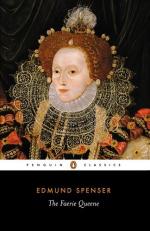2. The Reformed Church, no longer under the guidance of Truth, rushes headlong into Infidelity, and unwittingly became the defender of the Romish Faith under the name of the True Faith. There is a hint of the intrigues of Mary Queen of Scots and the libels of the Jesuits on Queen Elizabeth designed to bring back the English nation to Romish allegiance.
LINE 1. THE NORTHERNE WAGONER, the constellation Bootes.
2. HIS SEVENFOLD TEME, the seven stars of Ursa Major, or Charles’s Wain. THE STEDFAST STARRE, the Pole-star, which never sets.
6. CHEAREFULL CHAUNTICLERE, the name of the cock in the fabliaux and beast epics, e.g. Roman de Renart and Reineke Fuchs.
7. PHOEBUS FIERY CARRE, the sun.
11. THAT FAIRE-FORGED SPRIGHT, fair but miscreated spirit (I, xiv). Spenser took suggestions for this stanza from Ariosto and Tasso.
51. FAIRE HESPERUS, the evening star.
55. THE ROSY-FINGRED MORNING. This beautiful epithet of Aurora, the goddess of the dawn, is borrowed from Homer, Hesiod, and other ancient poets.
56. AGED TITHONES, son of Laomedon, King of Troy. Aurora conferred upon him immortality without youth, hence the epithet “aged.”
58. TITAN, the sun-god in the Roman myths.
85. PROTEUS, a sea-god who was endowed with the power of prophecy. He could change himself into any shape in order to avoid having to prophesy. See Homer, Odyssey, iv, 366 seq., and Vergil, Georgics, iv, 387.
90. HERBES. In the sixteenth century the belief in potions, magic formulas, etc., was still strongly rooted in the popular mind. The Spanish court and the priests were supposed to employ supernatural agencies against the Protestants.
105. A FAITHLESS SARAZIN. Spenser uses the word Saracen in the general sense of pagan. During the Middle Ages the Saracen power was a menace to Europe, and the stronghold of infidelity. The names of the three Paynim brethren, Sansfoy, Sansjoy, and Sansloy,—faithless, joyless, and lawless,—suggest the point of view of Spenser’s age.
109. A FAIRE COMPANION, the enchantress Duessa, or Falsehood, who calls herself Fidessa. In the allegory Spenser intended her to represent the Romish church and Mary Queen of Scots. Her character and appearance were suggested by the woman of Babylon, in Revelation, viii, 4, Ariosto’s Alcina, and Tasso’s Armida.
136. AS WHEN TWO RAMS. This figure is found in Vergil, Apollonius, Malory, Tasso, Dante, and other poets and romancers.
141. THE HANGING VICTORY, the victory which hung doubtful in the balance.
144. THE BROKEN RELIQUES, the shattered lances.
148. EACH OTHERS EQUALL PUISSAUNCE ENVIES, each envies the equal prowess of the other.
149. THROUGH THEIR IRON SIDES, etc., through their armored sides with cruel glances, etc.




